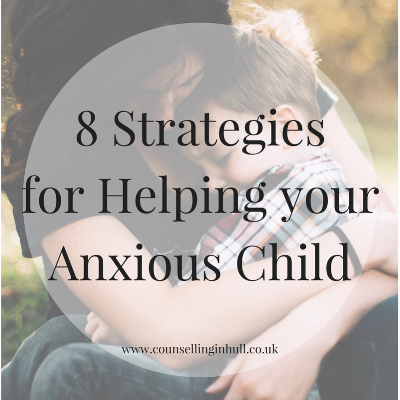8 Strategies For Helping Your Anxious Child
If you managed to catch the Facebook live: Understanding Anxiety in Children, then you'll be familiar with these strategies, but this will be a good refresher for you.
If this is your first time here, welcome. This blog will give you some ideas about how to work with anxiety in general, but specifically with children that struggle with anxiety.
If you haven't read Anxiety Basics yet, you may want to start there. Another useful blog covers Day-to-day strategies to Positively Impact your Child's Anxiety.
Let's begin:
1. Work With Their Anxiety
We all know what anxiety feels like and when we see someone we love feeling anxious, we may go into rescue mode in order to try and stop them feeling anxious or we may struggle with our own emotions and try and shut their anxiety down with our own frustration. If you do this by trying to reason with them at the time they're feeling anxious, you're not likely to get your desired outcome because their nervous system is on autopilot, what they need is to calm down and get grounded - you need to work with their anxiety
Breathe
Encourage your child to breathe into their tummy and out again slowly until their heart rate slows down and they start to feel calm. This is reversing the impact of Adrenaline and Cortisol in their bloodstream, the chemicals that causes their body to go into the flight or fight response.
Empathy
Align with them, let them know you're there, that they are OK and doing well. Anxiety can feel really scary because it often comes with feeling like you've lost control over your own body, let them know that you know this and it's OK, it will pass and to keep breathing.
You're giving them the permission to focus on themselves instead of having to overcoming the trigger, you're giving them permission to need and take this time which in the long run will help their anxiety because they're less likely to feel anxious about being anxious.
Reflection
Once they have calmed down, spend some time to explore what happened. When you first start doing this they may struggle, but by taking the time to be curious together, they will feel supported and important. As they become more familiar with what triggers their anxieties and their internal reactions to them, they can start to develop a toolkit. Encourage them to think about their thinking, did they access what they know to be true or their fantasy thinking of all the things that could be. Encourage them to notice the helpful and the unhelpful things they did i.e. did they tell someone or did they withdraw - do they think this was helpful or unhelpful and what do they think they could try next time?
2. Teach Them What You Know
If you haven't already, read Anxiety Basics and teach them this. When I worked with a 6 year old who was showing signs of anxiety in social situations, we externalised the anxiety by creating a character and she called it Mrs Frightened. We wrote a bio for Mrs Frightened which gave the opportunity for us to explore who she was, what her purpose was, what she liked and what she didn't like. The 6 year old was able to see that Mrs Frightened's job was to keep us safe (evolutionary survival) but that sometimes, she gets things wrong and sees danger when there isn't any. We did power poses in the mirror and confidently told Mrs Frightened she was wrong (...parties are fun not dangerous).
3. Be Creative & Use Humour
Like in the example above, being creative with a difficult concept helps children relate to the topic and understand in a playful way. When children feel overwhelmed or lose interest, it's often because it's too close to home i.e. it's about them or it's too difficult to understand. Creativity also accesses different parts of the brain which means the issue is processed much deeper in the system (brain/body system).
Give It A Name And A Body
How big does worry, anxiety or being frightened feel? What colours would suit it? Does it look like a human or different? Where does it live and what does it do all day? How heavy is it, how do they feel towards it when they visualise it? This is also great to help you understand their experience of it. I do this with clients of all ages.
Make It
Using play dough or art and craft materials, experiment with their experience of anxiety (or what ever word they use themselves). They will be processing their experience whilst also developing a sense of ownership and responsibility without being told that this is theirs and they are responsible. Don’t let any challenges with being creative get in the way, pen and paper is more than OK.
It's Story
Using a large piece of paper, draw 6 equal sized boxes. In each box create headings for the story board (make these relevant to the problem), each heading flows into the next and creates a full story with a beginning, middle and end. Invite your child to draw the story for each box and spend time talking about what they have drawn. If there's a super hero, what qualities does it have and can you see those qualities in your child or can they see the qualities in people they know i.e. their safe people? Here are some headings to get you started (one heading in each box):
Box 1 - Who is the main character?
Box 2 - What is their challenge?
Box 3 - What gets in the way of them succeeding?
Box 4 - What helps them succeed and overcome the problem?
Box 5 - What happens when they succed?
Box 6 - How does the story end?
4. The Power Of Thought
If you're being creative with teaching them and allowing them to explore their difficult feelings, this leads nicely to explaining the power of thought. When they are problem solving in their 6 part story, they will be developing confidence ready to do it in their own story.
Thoughts trigger emotions, emotions trigger the behavioural response.
It's important to encourage our children to be aware of their internal dialogue (their thoughts) and to be comfortable with externalising it/talking about it. When it's externalised, it reduces overthinking and getting stuck in their own heads. When they're talking about it, we can influence it and explain - we are also accessing co-regulation with our safe person.
Not All Thoughts Are True
We can be our own investigators, we can collect the evidence which supports our thoughts or we can collect evidence that disproves it.
Not All Feelings Are Facts
If we're using our intense feelings to assess and predict a situation, we're likely to overestimate, we need to be checking things out/talking/asking.
5. Time Travelling
Anxious worries are often based in the future, this often means we're not present in the moment when we're anxious. A way to break the cycle is to teach mindfulness, notice what is around you, what options you have right now, what feels good right now.
6. Allow Them To Worry & Create Time For It
Who's ever said "don't worry about it"?
We know that phrase is unhelpful, but often, we don't know what else to say. I'm hoping that this problem is changing and you're developing lots of new ideas of what to say and what to do to manage worry.
Another thing to consider is making time for worries. Taking time out of the stress and the chaos of family life, to check in with the worried parts of ourselves. Worrying doesn't change anything yet sometimes, if done regular enough, it can feel like a strategy. Internally, worrying can feel right because it shows we care (but it doesn't change anything) and worry can mean we're at least doing something, we're busy worrying (but it doesn't change anything).
Creating time for worries, such as worry time, a worry box, a worry catcher, letters to the worry monster or a worry diary means we can put the thoughts into use; we can change the passivity or worrying into an action or we can self-soothe and tell ourselves what we know to be true (using our developing detective).
Remember This All Takes Practice.
In essence, what you're doing is re-training unhelpful patterns of thinking, feeling and doing.
7. Avoid Avoiding Anxiety
Once you and you child become more familiar and comfortable around working with anxiety, it's important that you stop avoiding anxiety. Avoiding anxiety works as a safety behaviour, it feels good in the moment (providing the temporary safety) because we're not having the anxious feelings, but it doesn't allow anything to change, it doesn't provide opportunity to push and grow through our fears; it keeps us stuck!
When clients are ready to start making changes in their life, we often use a ladder of tolerance. We start with the least threatening scenario and build to the biggest challenge and we work through them, constantly referring to what they've learned so far and processing the impact of each achievement. When clients say things like "I can't believe I've avoided doing that for 8 years, it actually feels great" you know that's what we need to be doing more of.
8. Co-regulation & Self-regulation
Whether your children are young, teenagers or early 20's, we all feel better when we know we have external resources for the times we feel stuck or helpless. It's important to help your children identify who they have in their life who they can trust and who make them feel safe. Do they know what they would do if one person was unavailable, if they said they were too busy or if they were on their own?
Knowing we have a support system can help us feel safer; people are there if we fall, that it's OK to fall and need people/ask for help.
When I work with clients who have anxiety, we always look at their support system and I encourage them to access it whilst we work on developing their internal resources. If we rely on the external world to feel safe and OK 100% we will always feel vulnerable, ideally, we need to develop our ability to self-sooth (using the strategies discussed in this blog) and have external resources available by having supportive people for the particularly tough times.
Subscribe to my YouTube channel.
You can also sign up for my newsletter which will mean blogs like this, offers and videos come straight to your inbox - sign up here.
Other Blogs You May Find Useful:
When is the Right Time to Speak to Children about Mental Health?
My Top 5 Tips and Useful Phrases when Talking to Children about Mental Health
When is the Right Time to Speak to Children about Mental Health?
Day-to-Day Strategies to Positively Impact your Children's Anxiety.

